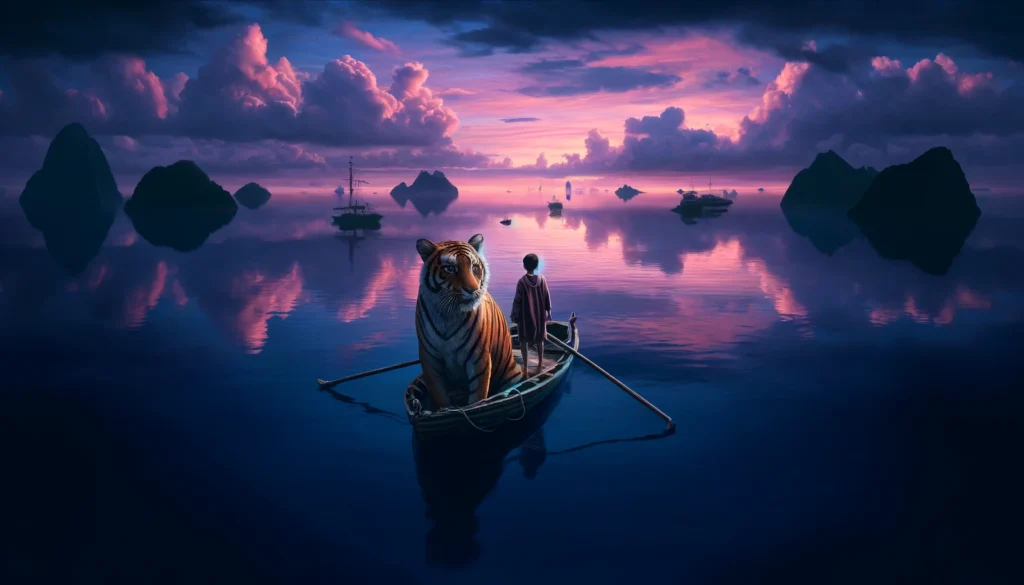Welcome aboard, curious navigators of truth and fiction! Are you strapped in? Because today, we’re embarking on a whimsical journey into the heart of “Life of Pi,” the film that has us all questioning whether a boy could really survive a shipwreck with a Bengal tiger. Grab your life jackets and your sense of wonder – we’re setting sail into the fantastic to find out if there’s any real water beneath this story’s beautifully crafted boat.

Is “Life of Pi” a True Story?
“Life of Pi” spins out from the creative loom of Yann Martel’s 2001 novel and was later captured on film by Ang Lee in a spectacle that can only be described as visually transcendent. The tale follows Pi Patel, a young boy who survives a disaster at sea, cast adrift in the Pacific Ocean in the close company of a tiger named Richard Parker. Now, before you start believing in the possibility of wildlife companions on lifeboats, let’s clarify: “Life of Pi” is a brilliant tapestry of fiction, rich with metaphorical threads that weave through themes of survival, faith, and the human spirit.
Delving Into the Heart of “Life of Pi”
At its core, “Life of Pi” is an exploration into the depths of human belief and the resilience required to hold onto hope against the relentless seas of despair. The novel, and its film adaptation, challenge us to consider the layers of our reality – is what we experience more about the truth of the facts, or the truth of our perceptions? Martel’s story pushes us into the murky waters of existential thought, where we must confront what constitutes our reality: the physical world we can touch or the inner world shaped by our beliefs.
What Happens at the End of “Life of Pi”?
The conclusion of “Life of Pi” might just flip your boat. After Pi is rescued and recuperating, he recounts his incredible tale to skeptical officials. However, he offers them not one, but two versions of his ordeal – one involving the zoo animals and a more brutal version with humans in the roles of the animals. This clever narrative choice forces us to wrestle with the concept of subjective truth and the power of storytelling as a means to cope with trauma.
Where Are the Protagonists Now?
Since we’re dealing with a story spun from the threads of fiction, Pi Patel and Richard Parker don’t have GPS coordinates we can track. But metaphorically speaking, Pi sails on in the minds and discussions of those who encounter his story, sparking debates and insights on truth, faith, and survival. Richard Parker, as an embodiment of raw, untamed nature, prowls through the jungles of our imagination, a reminder of the wild within and the primal instinct to survive.
The Cinematic Triumph of “Life of Pi”
“Life of Pi” is not just a story well told but also a visual masterpiece that earned it accolades, including several Academy Awards. The film merges the marvels of modern technology with the timeless tug of a good narrative, creating a spectacle that challenges our senses and perceptions. It’s a testament to how cinema can expand our understanding of the world and ourselves.
Is “Life of Pi” a Good Movie?
To ask if “Life of Pi” is a good movie is like asking if stars are magical; the answer lies in your belief in magic itself. This film is a profound journey that combines stunning visuals with a storyline that invites deep reflection. It’s a cinematic piece that dares us to believe in the extraordinary and to question the nature of our realities.
Similar Journeys in Storytelling
If your thirst for tales that blend reality and fiction remains unquenched, consider venturing into stories like “Big Fish” or exploring the narrative realms of “The Fountain.” These films, like “Life of Pi,” offer rich landscapes for the imagination and are steeped in the themes of human experience and existential musings.
Summary: Charting the Course of Belief and Reality
“Life of Pi” may be a work of fiction, but its journey across the oceanic expanses of our minds is as real as they come. It challenges us to find the truth in our tales and the tales in our truths. In the vast, sometimes isolating oceans of life, stories like Pi’s serve as our lifeboats, crafted not from wood or steel, but from the buoyant material of hope and humanity. Whether you see Pi’s journey as a testament to human endurance or a parable on the power of faith, it’s a voyage worth taking. So let the currents of “Life of Pi” pull you into a sea of deep contemplation and even deeper wonder.







